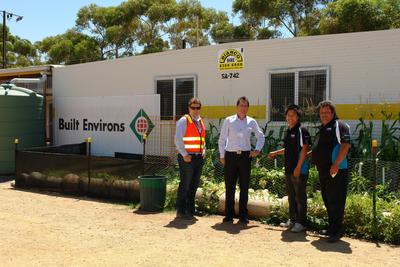Green thumbs up for site office
Thursday, 27 September, 2012
Most site huts occupied by building construction companies are very basic. Kettles and fridges are usually the only concessions to comfort while little consideration is given to conserving energy, as most adopt a “Will the last person shut the lights off?” approach.
But not anymore. Adelaide construction company Built Environs has turned that concept on its head.
The company’s temporary site office at the Edinburgh RAAF Base LEAP (Living Environment Accommodation Precinct) is fitted with state-of-the-art C-Bus lighting control technology, motion sensors, timers and sunset switches. It is designed and programmed to conserve as much energy as possible.
The office even collects rainwater, which is used to maintain a vegetable garden that staff and contractors tend to during work breaks.

“We wanted to reduce our carbon footprint,” said Tony Jachmann, Built Environs Project Manager.
“It’s a culture we decided to adopt even in our construction site huts. Normally in these temporary offices, we would have the lights and aircon going 24/7. Our LEAP Project office is actually five shells bolted together and this project is not due for completion until 2013, so that’s a lot of energy that would go to waste.”
After discussions with Tony Fagan, CIS Sales Manager, Clipsal by Schneider Electric, and C-Bus Approved Installer Andrew Fragnito, from DVise Solutions, the team designed and implemented a C-Bus lighting control system. C-Bus provides master on and off switching, activates designated lighting in common areas, and times out lights with motion sensors in isolated offices, kitchen and lunch areas.
The system cleverly bypasses the staff fridge and times the hot water boiler to activate first thing in the morning. C-Bus even activates air-conditioning units at 5 am, prior to staff arriving for work, and times them out in the evening at 6.30 pm, when the site office is no longer occupied.
“It was an unusual but not a difficult job for our team to wire,” said Fragnito.
“The office shells were already prewired so we had to run surface conduit down the walls to accommodate the C-Bus wiring. Programming the system was straightforward. We installed a C-Bus Wiser system. This enables Tony to check the status of the lighting and manually override the system via his iPhone.
“It’s a clever app and gives Tony options to control the system and even monitor energy consumption.”
The C-Bus system is very flexible and can be reconfigured and programmed for any future need.
“These huts we use, we re-use,” said Jachmann. “When we are finished, we will unbolt it and use it again for the next project. It’s worked out well. The system is user friendly and we know we’re saving energy.”
Fagan estimates that Built Environs‘ energy savings are significant.
“We believe at the very least that the client is currently achieving energy savings of at least 30%. Importantly, they are walking the talk and creating a genuine energy efficiency culture.”
As for the veggie patch, which is currently abundant with tomatoes, cucumbers and watermelons: “It was an interesting concept which just started with an idea,” said Jachmann.
“We had the rainwater and decided to start a garden. Not everyone has an iced coffee or smokes during their break; however, they enjoy a bit of time out, watering the garden and looking after the plants. It breaks the day and fits in well with the low-carbon direction we are taking.”
Tackling energy insecurity in remote communities
Researchers from Flinders and Macquarie Universities have presented the benefits of community-led...
Paper-thin LEDs that are kinder to the eye
A new, experimental LED is nearly as thin as paper and emits a warm, sun-like glow.
How clear windows can harvest energy
Researchers have created a colourless solar concentrator that can be directly coated onto...



